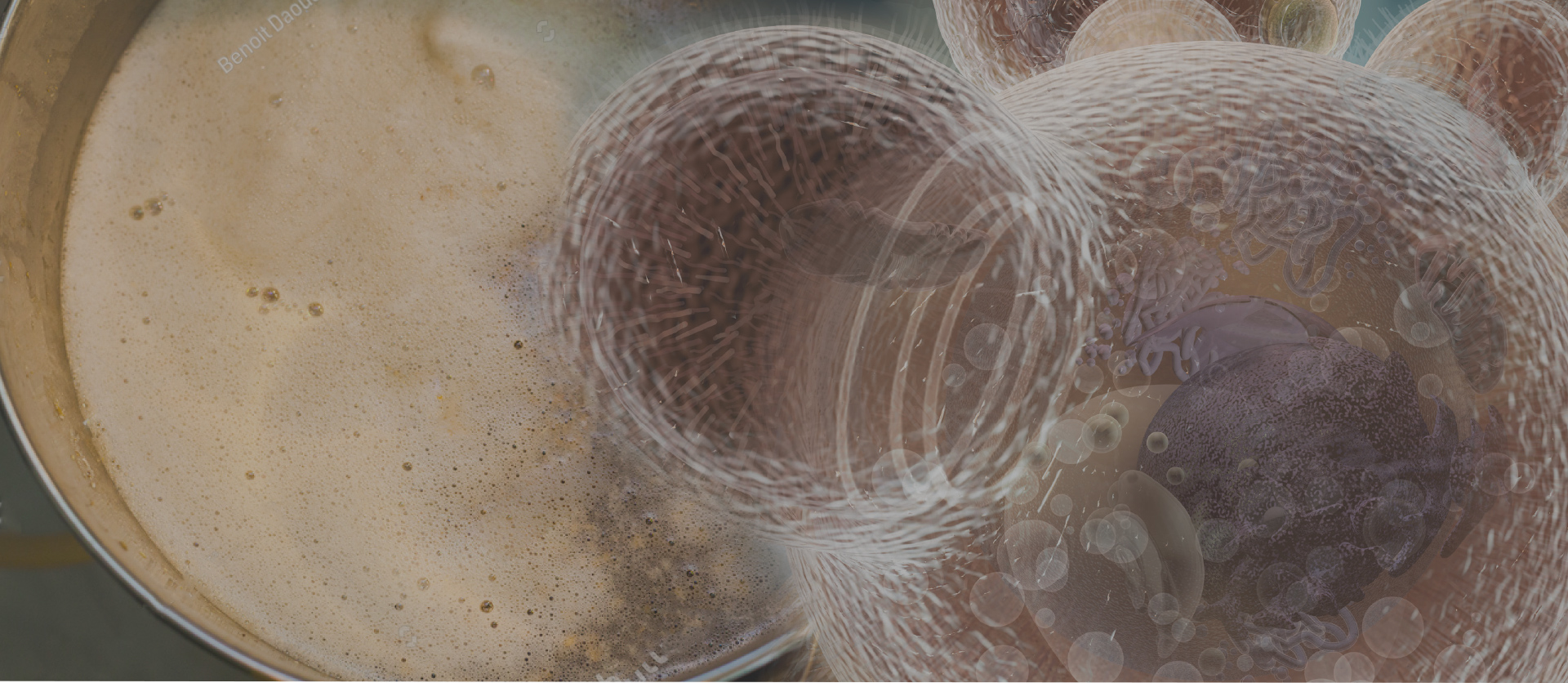Reliable Pitch Rate for Reliable Fermentation
The Next Generation
The Next Generation of PurePitch® is finally here with key advancements to make your brew day easier. One of the most important is that PurePitch® is NOW AT 2X THE PITCH!
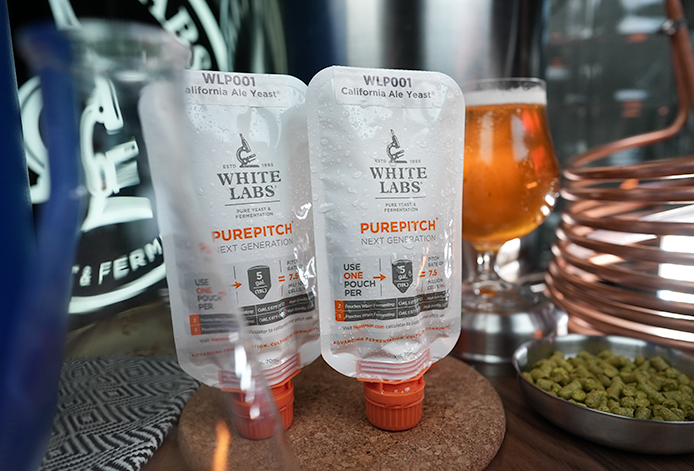
What About Those Pitch Rates
In our decades of research and working with brewing partners, we know that having a precise pitching rate is the key to a successful fermentation for the best beer every time. With PurePitch® Next Generation, we have standardized the cell concentration and created a simple, modular design to give you the optimal pitching rate.
Our recommendation of pitching a consistent 7.5 million cells/mL is a commercially recommended pitching rate for standard ale ranges.
The same package has proven to be an optimization to PurePitch® for larger professional brewers for over a year.
The same package has proven to be an optimization to PurePitch® for larger professional brewers for over a year.
Higher Viability and Better Shelf-Life Lets You Pitch Whenever
Because we never stop, PurePitch® Next Generation has an improved proprietary film designed specifically for White Labs and allows for one-way off-gassing to reduce product inflation and deliver higher yeast health and longer shelf life. White Labs is the industry leader in quality with the same quality and care taken for every culture, including proprietary qPCR methods (developed with Invisible Sentinel) for higher limits of detection. With 38 quality checkpoints for every single strain, you can be assured that all products released from White Labs have passed rigorous tests to ensure the highest viability and purity at the time of QC release.
PurePitch® Next Generation packaging improves yeast performance:
PurePitch® Next Generation packaging improves yeast performance:
- Maintains high yeast glycogen reserves, so yeast stay healthier and perform better when used in fermentation
- Eliminates the negative stress of CO2 build-up in the package, leading to bloated packages and an unfriendly environment for the yeast
As part of our intensive quality control procedures, we routinely monitor the viability of our strains over time. We ensure that yeast leaves our facilities above 95% cell viability and we have seen that yeast stays highly viable (over 90% on average) for up to 7 months from date of production release!
The long shelf-life and sustained viability mean that you can confidently pitch any White Labs culture within the use-by date printed on the package and get a successful, healthy fermentation.
Why Does Pitch Rate Matter: More Consistent Beer Flavor
Consistency is key! Consistent Yeast growth = Consistent Beer Flavor. From fermentation, yeast consumes fermentable sugars into carbon dioxide and ethanol. But they also produce over 500 different flavor and aroma compounds in the beer. Different Pitch rates can lead to different problems!
Changes in pitching rate can affect
- Flavor production
- Length of fermentation
- Health of future generations
- Flocculation
- Harvesting
Risk of Underpitching/Overpitching
Underpitching
- Underpitching gives more room for yeast cells to grow and reproduce, therefore creating more yeast-derived flavor in the beer. This can work well in styles such as wheats, belgians, and saisons.
- Underpitching can also lead to stalled fermentations and inadequate clean-up of “off” flavors in the beer maturation phase
- With more yeast growth, there will be more cell growth leading to mutations such as flocculation characteristics
Overpitching
- Overpitching leads to less cell growth and less yeast-derived flavor
- Overpitching can also lead to sluggish fermentations over multiple generations, as with less cell growth means an older yeast cell generation for subsequent batches.
- See the graph below as fermentation speed degrades through subsequent batches with different pitch rates
Customize Your Pitch Rate based on your batch specifics

Working with high gravity brews or lower fermentation temperatures?

Learn More About PurePitch® Next Generation
Matched keywords: 1
Project Sustainability: Green Malt Project pt.2
White Labs and Green Malt
Green Malt, or freshly germinated grains but not yet dried or kilned, has been proposed as an alternative to save water and energy in the brewing and distilling process. These grains present higher α- and β-amylase activity than normal base malt, with a great capacity to convert starch into fermentable sugars and contribute to higher levels of nutrients for the fermentation. Introducing Green Malt in the process could provide an opportunity for craft producers to gain more control of their supply chain by partnering directly with local farmers to reduce their carbon footprints and create product innovations. However, some technical and flavor challenges limit the wide application of Green Malt in the craft brewing and distilling industries.
Empirical, a Copenhagen-based company that produces grain-based spirits, shared the same concerns and goals as White Labs, so our Copenhagen team worked together with them to assess the implementation of Green Malt in a craft brewery/distillery production.
Read part 1 of the Green Malt Project
Pilot Scale Steeping and Germination
Having selected a barley variety with improved flavor and aroma contributions that were compatible with our simplified germination system, the next step was to scale up and do a pilot-scale run. To scale up our germination system while using as little space in the brewery as possible, we used 200 L drums containing a false bottom to allow filling and draining from the bottom and for aeration of the grain bed, along with drum rollers on the bottom to allow for easy transport (Fig. 3, left). Moist air flow through the bed was introduced by a pressurized keg of soft water attached by hoses to the bottom of each drum (Fig. 3, right.)
Figure 3. Converted drums for steeping and germination. Converted drum during initial steeping (left) and full system for germination (right).
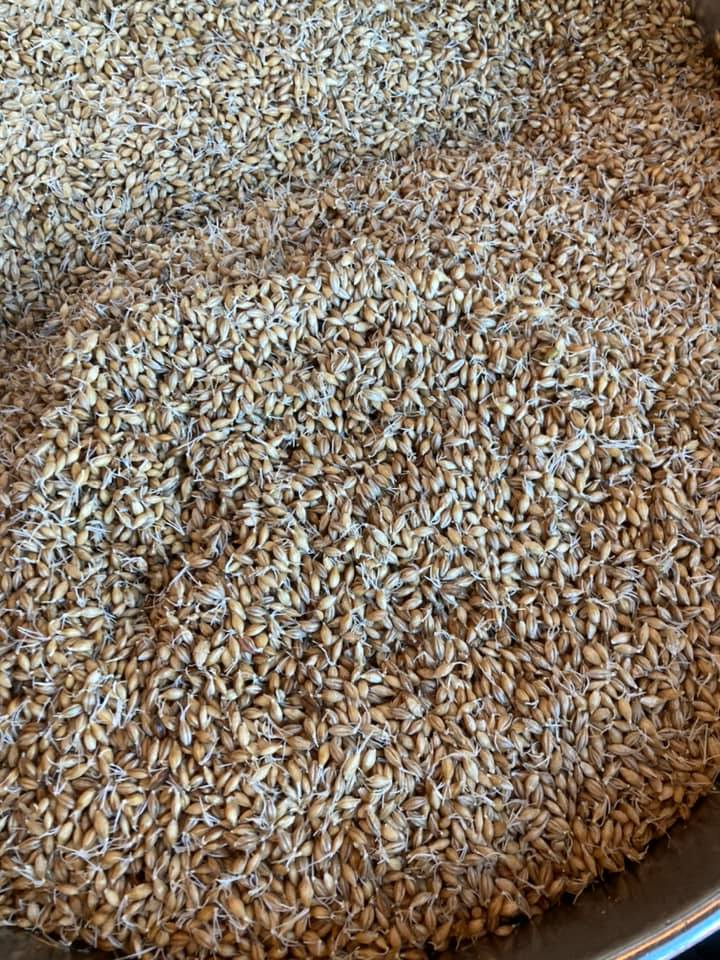


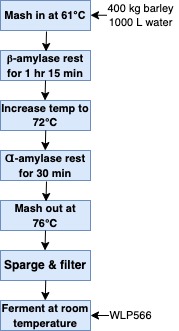
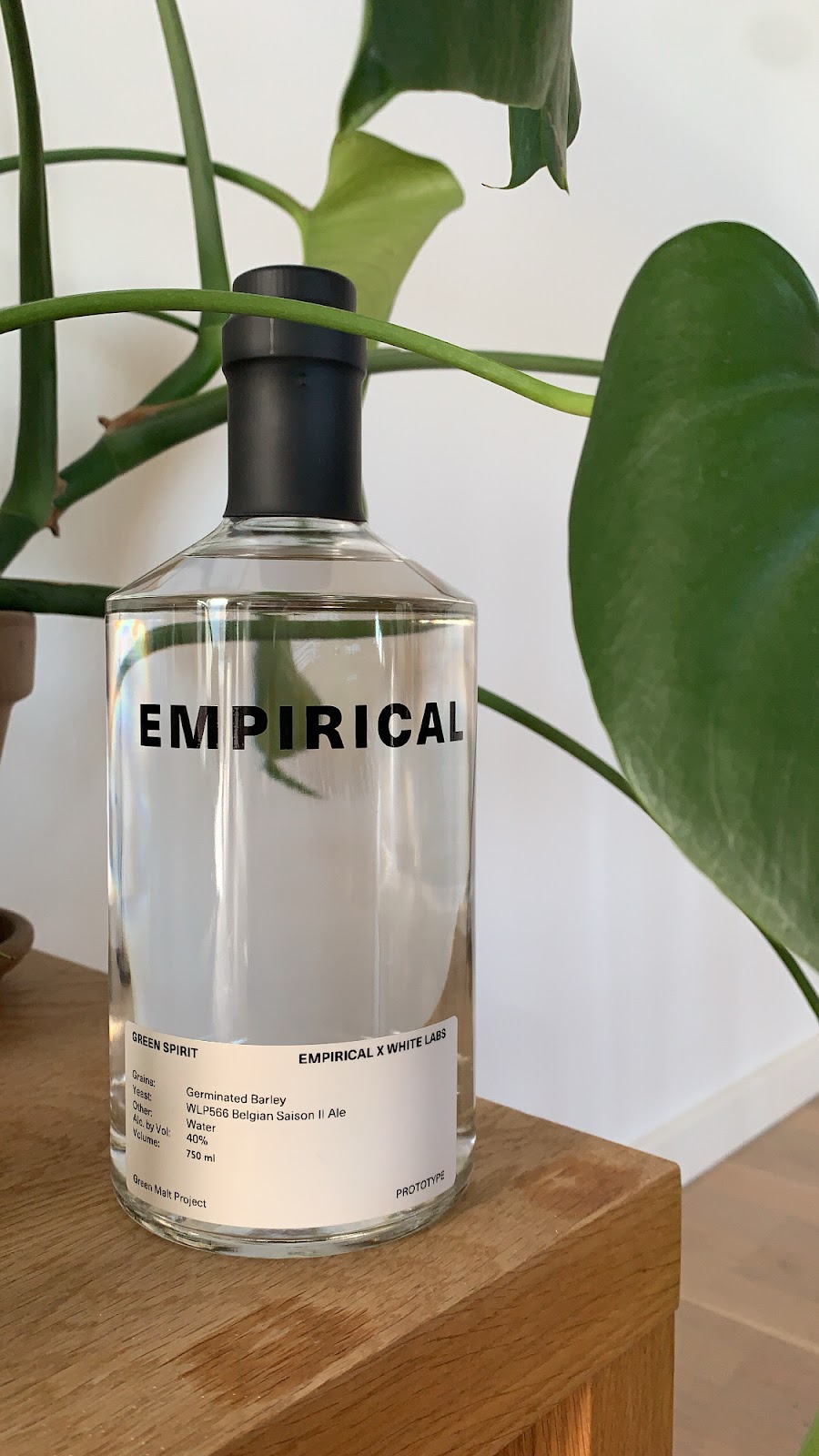
The first scale-up trial utilized 400 kg of barley, which was weighed and divided into four separate drums, 100 kg each. The grains were washed with soft water before being immersed in water for the first steeping, drained, and allowed to air rest overnight, followed by a second steeping and germination period (Table 3).
Table 3. Steeping/germination protocol for scale-up trial.
| Process | Description |
| 1ST STEEPING | ∙ 4-6 hours at 16-18°C in drums ∙ Mixed and temperature recorded ∙ Air compressor was attached to bottom valve and roused once to keep oxygen levels high ∙ Drained |
| AIR REST | ∙ 12-18 hours at 16-18°C in drums ∙ Mixed and temperature recorded ∙ Air compressor was attached to bottom valve ∙ High moisture air forced through the grain bed overnight |
| 2ND STEEPING | ∙ 4-6 hours at 16-18°C in drums ∙ Mixed and temperature recorded ∙ Air compressor was attached to bottom valve and roused once ∙ Drained |
| GERMINATION | ∙ 24 hours at 18-20°C in drums ∙ Mixed and temperature recorded ∙ Air compressor was attached to bottom valve ∙ High moisture air forced through the grain bed overnight |
Special attention was given to mixing the grain bed to avoid overheating due to the exothermic activity of the respiring grains and prevent the rootlets from tangling together. This further helped dispel any built-up CO2 and keep the grains oxygenated. Temperature was controlled and monitored throughout using a long thermometer capable of reaching deep into the grain bed.
The entire “malting” period of Green Malt took approximately 48 hours. Germination was deemed finished when the rootlets had grown considerably outside the grain, confirming that the endosperm was well modified. The production of brewing-relevant enzymes (ɑ-amylase and β-amylase) during the steeping and germination steps was determined (Table 4). The production of ɑ-amylase increased significantly over the germination process and reached values higher than the lab-scale tests at 24 hours (Table 4). Once the grains were deemed sufficiently germinated, around 24 hours, they were transferred to a mash tun and subjected to continuous steep milling (or wet milling) (Fig.4).
| Table 4. Enzyme activity over the germination step of α-amylase and β-amylase. |
|||
|---|---|---|---|
| Step | Time (Hours) | α-amylase (Dextrinizing units) |
β-amylase (Windisch-Kolbach units) |
| Germination | 0 | 5.14 | 256.43 |
| Germination | 18 | 9.85 | 245.46 |
| Germination | 19 | 11.37 | - |
| Germination | 20 | 12.9 | 216.31 |
Figure 4: Green malt being transferred to mash tun.
Brewing, Fermentation, and Distilling
To test the suitability of Green Malt for brewing applications and assess its flavor and aroma contribution to a distilled product, the Empirical team designed a brewing and fermentation schedule that would maximize the contribution of the freshly malted grain. The 400 kg of grains and 1000L of water were mixed, ground through a wet hammer mill, and sent back into the mash tun in one continuous stream. After mashing (Fig. 5, left), the wort was sent through a mesh filter press to remove the grain solids, then a chiller to cool it down and transferred to a fermentation vessel, ready to be pitched with White Labs Belgian Saison II Ale Yeast (WLP566).
Fermentation commenced at room temperature. Fermentation was monitored daily, noting temperature, pH, and °Plato (Fig. 5, right). After 12 days, the fermented wash of 1000L was transferred to a vacuum still and distilled at 70 mbar between 24°C and 40°C for 24 hours. Low wine was collected and distilled again 70 mbar between 24°C and 42°C for approximately 24 hours, yielding a spirit. The collected tails from this spirit run were further distilled under the same conditions, yielding more than 100L of spirit (>50% ABV).
The trial process efficiency showed great potential for Green Malt utilization, with a margin for significant time savings on the mashing and fermentation steps in follow-up trials.
The trial process efficiency showed great potential for Green Malt utilization, with a margin for significant time savings on the mashing and fermentation steps in follow-up trials.
Figure 5. Brewing schedule (left) and fermentation curve of the Green Malt wort (right).
Sensory Analysis
The produced Green Malt spirit was evaluated using the Empirical panelist's team of experts in spirits sensory analysis. A descriptive test was carried out whereby the panelists were asked to blindly taste the three prototype products and list the associated sensory attributes. A preference test was also carried out, which involved blind-tasting prototype one (Green Spirit) and another clear spirit at the same ABV. This other spirit, made in-house by Empirical, was made using “traditionally” malted pilsner malt and purple wheat. The panelists were asked to state which of the two spirits they preferred.
Green Spirit received predominantly positive feedback, with the majority of descriptors being favorable: sweet, green, peppery, mineral, fruity, clove, earthy, floral, and nutty. The unfavorable flavor characteristics mentioned were nail varnish or band-aid. In the preference tests, the Green malt spirit was preferred by 71% of panelists compared to the alternative malt grain-derived spirit.
Based on the sensory analysis conducted, Green Malt showed a strong potential for use in the brewing/distilling industry from a flavor perspective. The spirit produced promising results, yielding many top notes like sweet, green, peppery, and floral. The flavor profile was so interesting that new batches of Green Malt spirit were produced, and small-scale trials for producing Green Malt-based beer are underway.
This demonstrates that the Green Malt is capable of producing a clean, tasty spirit, which in itself is extremely versatile. Some potential uses include usage in a canned cocktail, mixed drink, or to be cask-aged
-Lars William, Empirical Co-Founder
Green Malt also shows great potential for application in the production of microorganisms, as it yielded a light-colored wort with high vitamins and micronutrient content, and gravity above 15 °P, allowing for easy dilution to meet strain-specific requirements.
Perspectives on the Potential of Green Malt
Our trials showed that it is possible to germinate several hundred kilograms of barley in a craft brewery/distillery setup with very little extra equipment and footprint requirements. The customized drums can easily be used in other functions and processes to return the investment quickly. Conventional malting processes require a long germination period, as a significant loss of enzyme activity occurs during drying and kilning. The high enzyme activity measured in freshly germinated grains allowed for high conversion in the mash tun even at relatively short germination times (<24 hours). Furthermore, a short germination process minimized rootlet formation, reducing the associated off-flavors detected in the wort and final products. This high enzyme activity opens the possibility of using alternative non-malted grains, like sorghum and buckwheat.
Nevertheless, Green Malt yields grains with a moisture content of 35-45%, and handling those wet grains in the brewhouse poses the main challenge to the successful integration of Green Malt in a brewing operation. The Empirical brewhouse already includes adequate equipment to handle high-moisture grains of different origins, so Green Malt was quickly processed through existing operating procedures. However, a significant portion of the small and mid-size craft breweries and distilleries are not equipped to mill wet grains and mesh filter the porridge-like mash, and some investment could be required. The Green Malt was not tested in a lauter tun, but using Green Malt to replace part of the grist might allow for application in a more conventional system.
The application of Green Malt in a mid-size brewery/distillery showed much potential in the savings of water and energy while allowing for a fast enough process that could be easily integrated into daily operations. The permanent integration of the germination process in the brewery operations could further increase water savings by allowing the reusing of steeping water in multiple germination steps. The in-house process of grains allowed a careful selection of locally available varieties that matched the desired flavor and aroma profile while enabling a closer relationship with local farmers and decreasing transportation-associated carbon emissions.
Conclusion
The Green Malt trials at White Labs started more than 10 years ago, and we learned many valuable lessons during the initial trials, but it took the concerted efforts of different partners to source the grains, implement a new process, and develop a brand new product that highlights the uniqueness of the process (Fig. 6). In any industry, looking at current processes or methods and challenging them is the first step to make advances. Process improvements might range from increased efficiency (time and energy savings) and lower process footprint (water and CO2) to complete re-thinking of the supply chain, as in this Green Malt project. However, testing and implementing innovations, especially when involving sustainability, is a long process that requires the right partners and resources.
Figure 6. The final product of the Green Malt process, a clean and unique spirit that can be used for different applications.
Matched keywords: 1
White Labs Copenhagen APS
Organic Yeast produced by White Labs Copenhagen
White Labs Copenhagen ApS produces over 50 White Labs yeast strains and bacteria in certified organic format for European professional brewers and homebrewers, distillers and winemakers from our facilities in Copenhagen, Denmark. We also supply White Labs dry yeast to European professionals and homebrewers, along with stocking the entire portfolio of White Labs yeast strains in professional sizes.
White Labs Copenhagen strains cover virtually any beer style imaginable from IPAs, Hazies, lagers, stouts, Wits, Hefeweizens, Saisons, Kveik, dubbels, trippels, and other Belgian styles, and on and on.
Ordering across Europe
For European customers, ordering directly from White Labs Copenhagen means:- Convenient and efficient ordering for all European customers
- Overnight express courier delivery across Europe:
- Easy intra-EU shipping (no customs issues!)
- Minimal fuss for non-EU European orders (full compliance with UK, Norway, Switzerland customs for easy importing from the EU)
Order directly at www.yeastman.com, email your orders to [email protected] or simply call us directly on +45 31615142.!
Homebrew
The full selection of White Labs Copenhagen organic liquid yeast is available directly from White Labs Copenhagen in the White Labs pure 70ml homebrew packaging format, along with WLP001 Dry California Ale Yeast in 11g sachets.- Homebrewers: White Labs Copenhagen currently only sells business-to-business to European customers. Please contact your local homebrew supplier
- Retailers/suppliers: If you are interested in offering White Labs homebrew products, please contact White Labs Copenhagen customer service for more information: [email protected] or +45 31615142.
Lab Services
If you are having any quality control issues in your fermentations, products or at your facility, our lab is available to assist in identifying and solving potential issues. Contact us for a free 30 min online consultation where we will assist in identifying possible causes and talk through options available to you. Contact us directly at [email protected] or call us on +45 31615142.Private Strain Banking
You can bank your private strains directly with White Labs Copenhagen. Additionally, our lab can assist you with isolating strains and identifying the contents of your cultures on a project basis. Email [email protected] for more information.Innovation Campus Europe (ICE)
At our dedicated research facility in Copenhagen, Denmark, we conduct a wide array of fermentation innovation & development research supporting the food & beverage industry pertaining to any process where microorganisms play a vital role. Projects and products include innovative uses of fermentation in food, upcycling food side-streams, alternative beverages, like Kombucha, low and non-alcoholic beer, biotransformation, lactic acid bacteria for non-dairy cheese, green malt fermentation. Don’t hesitate to contact us directly if you would like to discuss possible collaborations.ORGANIC YEAST STRAINS produced by White Labs Copenhagen
Check out our Organic Strains Here
Yeast Nutrients & Enzymes
White Labs Copenhagen stocks a wide range of nutrients & enzymes in professional sizes to help improve and optimize your brews, including:
WLN2000 SeltzerMax
WLN2500 FanMaxBio
WLE3000 Candy
WLE3100 Time
WLE3200 No-D
WLN3500 Servomyces
WLE4000 Clarity Ferm
WLE4100 Ultra Ferm
Contact
- Kirstinehøj 1
- 2770 Kastrup
- Denmark
- [email protected]
- Phone +45 3161 5142
- White Labs Copenhagen Facebook
- White Labs Copenhagen Instagram
Danish Food and Veterinary Association Control Report
White Labs Copenhagen is an inspected and approved organic production facility. Read the report here.Matched keywords: 1
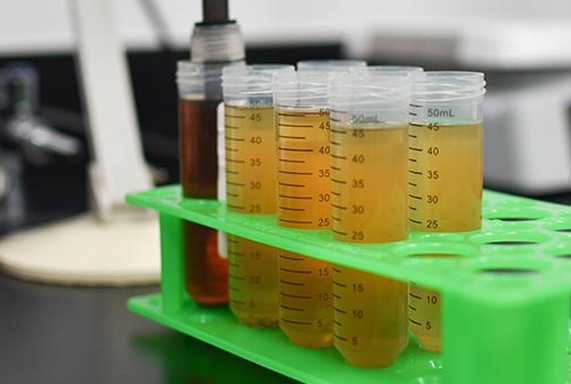 Yeast & Bacteria Bank
Yeast & Bacteria Bank
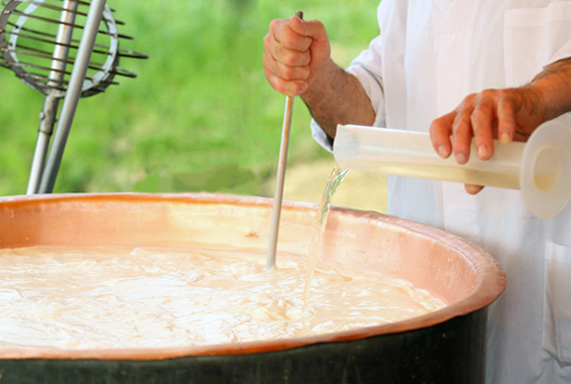 Enzymes & Nutrients
Enzymes & Nutrients
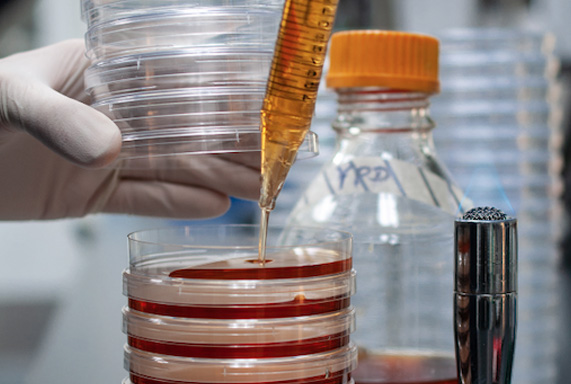 Lab Services
Lab Services
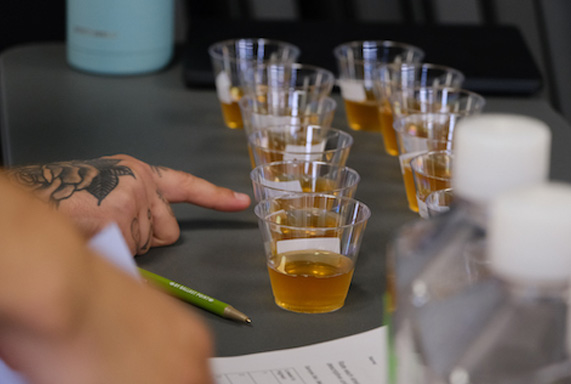 Education
Education
 Merchandise
Merchandise
